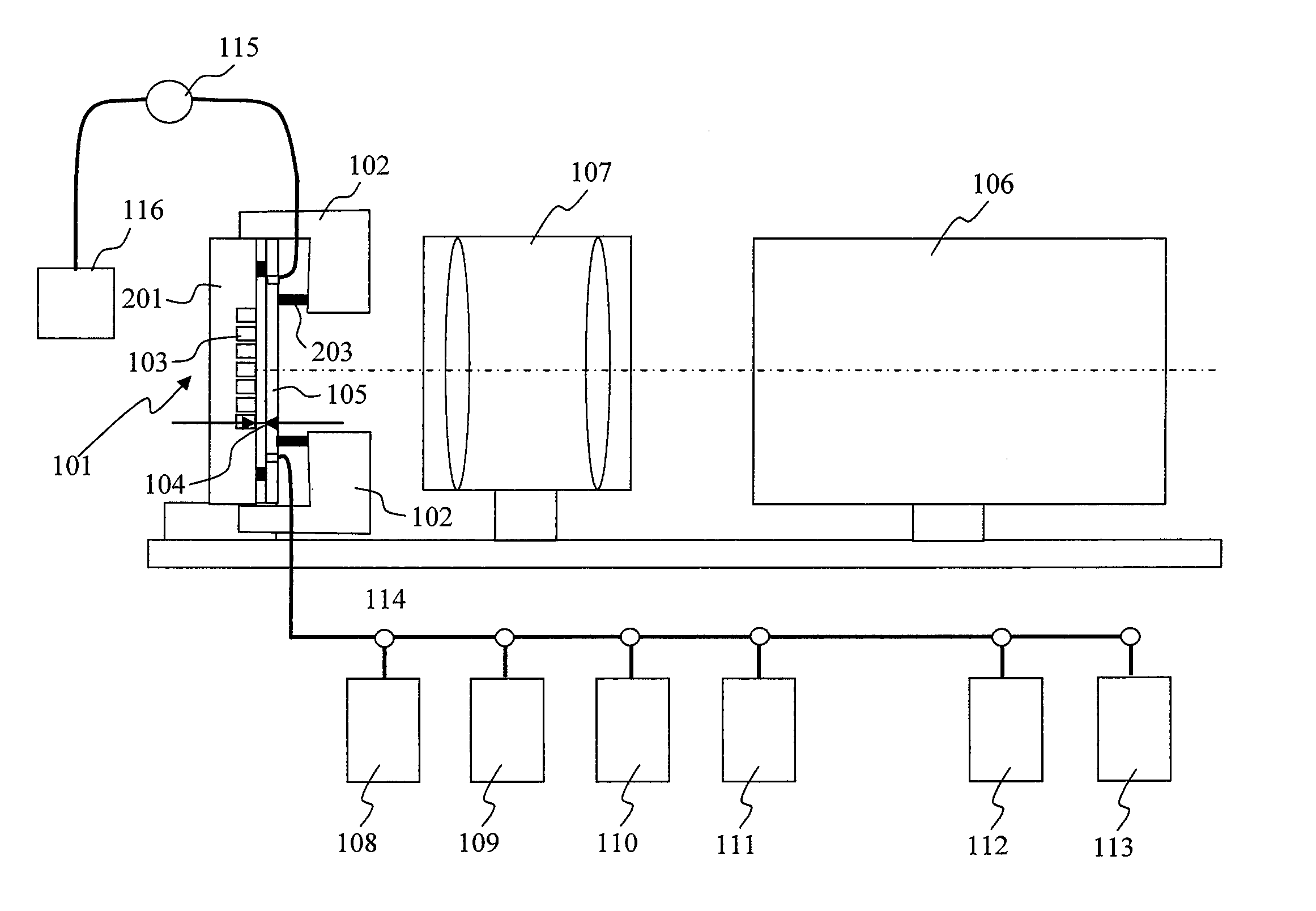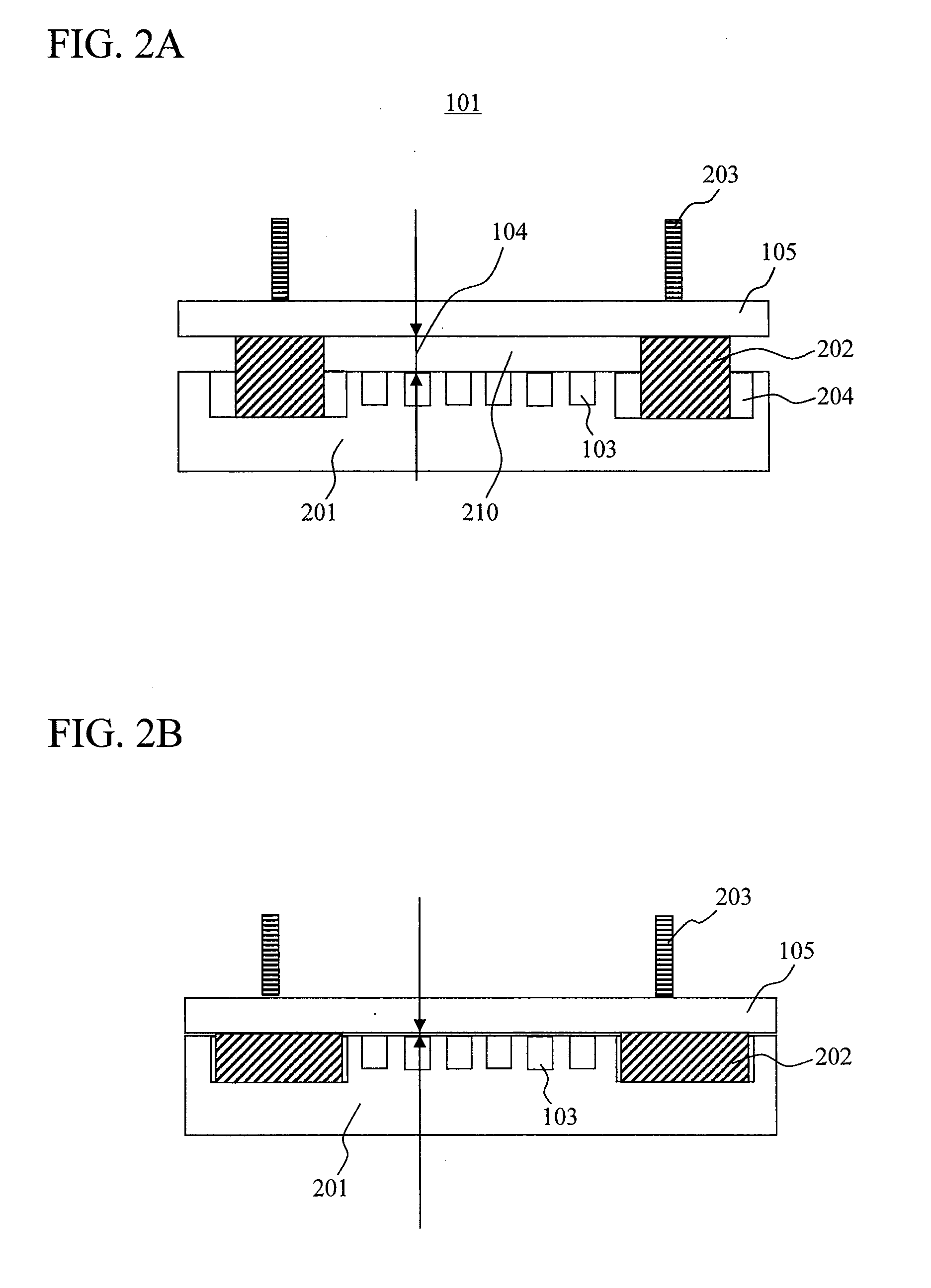Chemiluminescence analyzer
- Summary
- Abstract
- Description
- Claims
- Application Information
AI Technical Summary
Benefits of technology
Problems solved by technology
Method used
Image
Examples
example 1
[0038]FIG. 1 is a drawing illustrating a configuration example of a chemiluminescence analyzer according to the present invention. In the chemiluminescence analyzer of the present example, various reagents flow through a flow cell 101 formed by a plate 201 having a large number of micro-chambers 103 formed thereon and a transparent substrate 105, and chemiluminescence from each of the large number of micro-chambers formed on the plate 201 is measured to determine a sequence. In the present invention, the thickness of a flow channel for reagents flowing therethrough is changed between the time of chemiluminescence measurement and the time of supply of reagents to the micro-chambers while a reagent is flowing through so that a conductance, a cross-sectional shape, and a cross-sectional area of the flow channel is changed. As a result, at the time of chemiluminescence measurement, while crosstalk among adjacent micro-chambers can be prevented, luminescence intensity can be improved, re...
example 2
[0056]In Example 1, the flow channel thickness 104 was changed by causing elastic deformation of the spacers 202 so that diffusion of products from the micro-chambers 103 was inhibited. The present example is configured to achieve the same effect as in Example 1 by deforming a transparent substrate, serving as an upper plate of a flow cell, to change the thickness of the flow channel located immediately above the micro-chambers.
[0057]FIGS. 8A and 8B show schematic cross-sectional views of another example of the flow cell 101. In the flow cell 101 of the present example, it is configured that the flow channel thickness 104 can be reduced immediately above the micro-chambers 103 by bending the transparent substrate 701 with application of stress. FIG. 8A is a view illustrating a state when stress is not applied, while FIG. 8B is a view illustrating a state when stress is applied to reduce the flow channel thickness 104. In the present example, a part of the transparent substrate 701 s...
example 3
[0063]Instead of moving and deforming the transparent substrate and the plate 201, another transparent substrate is provided in the flow channel in the flow cell so as to prevent the diffusion of products from the micro-chambers 103. FIG. 11 shows a system configuration example of the chemiluminescence analyzer. In the place of the rods 203 and the driving section 102 in FIG. 1, electromagnets 1001 and a driving section 102 for supporting and driving the electromagnets 1001 are respectively provided.
[0064]FIG. 12A shows a schematic cross-sectional view of a state where the flow channel thickness of the flow cell has been increased, and FIG. 12B shows a schematic cross-sectional view of a state where the flow channel thickness has been reduced. In a configuration where a transparent substrate 1101 made of polypropylene is provided in the flow channel, and neodymium magnets 1102 (main components: neodymium, iron, and boron) are each covered on the surface with polypropylene having a t...
PUM
 Login to View More
Login to View More Abstract
Description
Claims
Application Information
 Login to View More
Login to View More - R&D
- Intellectual Property
- Life Sciences
- Materials
- Tech Scout
- Unparalleled Data Quality
- Higher Quality Content
- 60% Fewer Hallucinations
Browse by: Latest US Patents, China's latest patents, Technical Efficacy Thesaurus, Application Domain, Technology Topic, Popular Technical Reports.
© 2025 PatSnap. All rights reserved.Legal|Privacy policy|Modern Slavery Act Transparency Statement|Sitemap|About US| Contact US: help@patsnap.com



